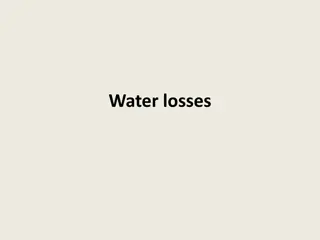Investigating Flash Droughts in Sicily Using Evapotranspiration and Soil Moisture Analysis
This study focuses on identifying flash droughts in Sicily by analyzing potential evapotranspiration and soil moisture anomalies. The research examines trends in evapotranspiration and soil moisture levels over the past 22 years, pinpointing a possible flash drought occurrence in eastern Sicily in 2
3 views • 29 slides
Understanding Irrigation Scheduling for Optimal Crop Yield
Scientific irrigation scheduling plays a vital role in determining the correct timing and quantity of water application for crops to enhance yields efficiently while preserving soil quality. Various criteria are utilized in irrigation scheduling, such as potential evapotranspiration (PET) estimation
13 views • 58 slides
Update on Drought Monitoring Indicators and Indices at SERCOM-3 Conference
The SERCOM-3 conference held in Bali, Indonesia, discussed the adoption of additional drought indicators and indices for use by National Meteorological and Hydrological Services (NMHS). The update to the Global Drought Classification System (GDCS) included recommendations for the use of standardized
0 views • 4 slides
Understanding Canopy and Surface Methods in HEC-HMS
Explore the various canopy and surface methods utilized in HEC-HMS for managing water resources. Learn about canopy interception, evapotranspiration, common parameter values, and factors affecting losses. Delve into available methods, canopy storage values, and surface depression storage. Enhance yo
0 views • 12 slides
Enhancing Crop Water Productivity in Sindh Province Using GIS and Remote Sensing Techniques
Investigating evapotranspiration dynamics in Sindh Province's canal command areas to improve water resource management and agricultural strategies. The project aims to assess crop water productivity, develop a web-based dashboard for information dissemination, and propose sustainable water managemen
0 views • 11 slides
Best Practices for Water Management in Agricultural Settings
Exploring various Best Management Practices (BMPs) for water management in agriculture, this content delves into definitions of detention and retention, EAA farm P load calculations, rainfall detention BMP goals, water detention methods, and mixed crop rotation strategies. The information covers red
1 views • 21 slides
Proposed Changes to CVWD's Landscape Ordinance - November 2015
CVWD's Landscape Ordinance, originally passed in 2009, underwent revisions in response to Governor Brown's 2015 drought actions. The ordinance was aligned with the State's requirements, with adjustments made to applicability, evapotranspiration factors, and irrigation efficiency rates to ensure wate
0 views • 28 slides
Basics of Crop Water Requirements in Irrigation Engineering
Understanding crop water requirements is crucial in planning effective irrigation systems. Crop water requirements are determined by factors such as evapotranspiration, soil conditions, and achieving maximum production potential. Effective rainfall, soil moisture storage, and groundwater contributio
0 views • 83 slides
Soil Moisture-Atmosphere Interactions in the 2003 European Summer Heat Wave
This presentation discusses the significant impacts of soil moisture-atmosphere interactions during the 2003 European Summer Heat Wave, highlighting the abnormally hot weather, pavement buckling, and high-pressure systems that contributed to the extreme conditions. The images and diagrams illustrate
0 views • 27 slides
UNESCO Stampriet TBA Project Data Availability Report February 2014
This report by Jürgen Kirchner provides information on the availability of data related to the UNESCO Stampriet TBA project, ranging from physiography and climate to hydrogeological characteristics and socio-economic aspects. It discusses temperature, precipitation, evapotranspiration, land use/lan
0 views • 35 slides
Simplified Landscape Irrigation Demand Estimation: SLIDE Rules for Water Budgets
Simplified Landscape Irrigation Demand Estimation presents a comprehensive guide on managing urban landscape water use efficiently. Collaborators from various institutions contribute to addressing the challenges posed by drought and climate change. The document explores plant water demand, atmospher
0 views • 29 slides
Monitoring Forest Cover Disturbances During Natural Hazards by Meteorological Satellites
Ecosystem functioning relies on energy, water, and carbon fluxes regulated by vegetation and soil properties. This study focuses on monitoring forest cover disturbances before, during, and after natural hazards using meteorological satellites. It involves analyzing land surface temperature, evapotra
0 views • 37 slides
Understanding Crop Coefficients in Colorado
Explore the application of crop coefficients for estimating crop evapotranspiration in Colorado, specifically at the Rocky Ford Lysimeters. Learn about the measurement methods, instrumentation used, and data collected through lysimeter projects. Gain insights into the Kcr curves for alfalfa hay and
0 views • 10 slides
Inference of Urban Water Storage Capacity from Evapotranspiration Recession Analysis
A new method is proposed to estimate urban water storage capacity based on evapotranspiration recession analysis, showcasing the significant differences between urban and rural/forested areas. The study highlights the strong water limitations in cities, leading to smaller water storage capacities. F
0 views • 4 slides
Understanding Water Losses and Evaporation in Hydrology
The hydrological equation explains the various factors contributing to water losses, including interception by vegetation, evaporation from water and soil surfaces, transpiration, evapotranspiration, infiltration into soil, and watershed leakage. Evaporation is influenced by temperature, humidity, w
0 views • 20 slides














